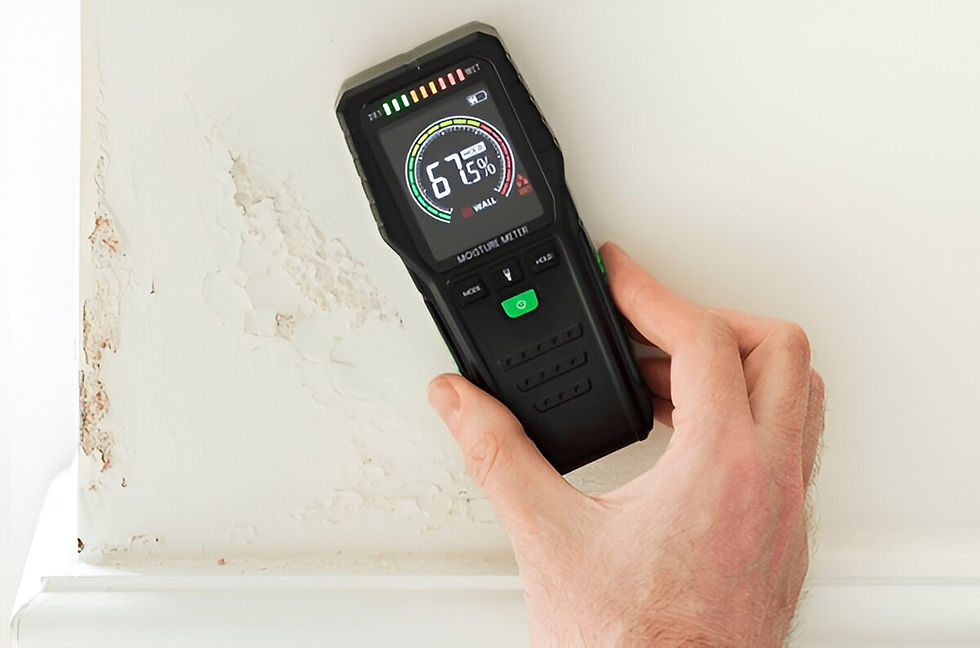Signs You Need a Visual Mold Inspection in Your Plainfield Property
- mariotovaropo
- May 2
- 4 min read
Mold growth in residential properties can lead to significant health risks and structural damage. Understanding the signs that indicate the need for a visual mold inspection is crucial for homeowners in Plainfield. This article will explore various indicators that suggest mold may be present in your home, the potential health implications, and the importance of timely inspections.
Understanding Mold and Its Risks
Mold is a type of fungus that thrives in damp environments. It can grow on various surfaces, including wood, drywall, and even fabric. While some mold is harmless, others can produce allergens and irritants that may pose health risks.
Health Implications of Mold Exposure
Exposure to mold can lead to a range of health issues, particularly for individuals with pre-existing respiratory conditions or weakened immune systems. Common symptoms include:
Respiratory Issues: Coughing, wheezing, and difficulty breathing can occur, especially in those with asthma or allergies.
Allergic Reactions: Sneezing, runny nose, and skin rashes may develop in response to mold spores.
Headaches and Fatigue: Prolonged exposure can lead to chronic headaches and a general feeling of fatigue.
Why Visual Mold Inspections Matter
A visual mold inspection is essential for identifying mold growth before it escalates into a more significant problem. Early detection can save homeowners from costly repairs and health complications.
Signs Indicating the Need for a Visual Mold Inspection
Recognizing the signs of potential mold growth is the first step in safeguarding your home. Here are some key indicators to watch for:
1. Musty Odors
A persistent musty smell is often one of the first signs of mold presence. This odor typically indicates that mold is growing in hidden areas, such as behind walls or under carpets.
Where to Check: Pay special attention to basements, attics, and areas with poor ventilation.
Action: If you detect a musty smell, consider scheduling a visual mold inspection to identify the source.
2. Visible Mold Growth
The appearance of mold can vary in color and texture. Common types include black, green, and white patches on surfaces.
Common Locations: Look for mold on walls, ceilings, and around windows or doors.
What to Do: If you see visible mold, it’s crucial to act quickly and arrange for a professional inspection.
3. Water Damage
Previous water damage from leaks, flooding, or condensation can create an ideal environment for mold growth.
Signs of Water Damage: Look for water stains, peeling paint, or warped wood.
Inspection Importance: Even if mold is not visible, past water damage may indicate hidden mold that requires inspection.
4. High Humidity Levels
Humidity levels above 60% can encourage mold growth.
Monitoring Humidity: Use a hygrometer to measure indoor humidity levels.
Preventive Measures: If humidity is consistently high, consider using dehumidifiers and improving ventilation.
5. Allergic Reactions
If you or your family members experience unexplained allergic symptoms while indoors, mold could be the culprit.
Symptoms to Watch For: Sneezing, coughing, and skin irritations may indicate mold exposure.
Next Steps: Consult a healthcare professional and consider a visual mold inspection for your home.
6. Condensation Issues
Excessive condensation on windows, walls, or pipes can signal high humidity and potential mold growth.
Where to Look: Check areas prone to condensation, such as bathrooms and kitchens.
Action Plan: If condensation is frequent, it may be time for a professional inspection.
7. Peeling Paint or Wallpaper
Peeling or bubbling paint and wallpaper can indicate moisture problems that may lead to mold growth.
What to Examine: Inspect areas where paint or wallpaper is damaged.
Inspection Need: Damaged surfaces may hide mold, necessitating a visual inspection.
8. Previous Mold Problems
If your property has a history of mold issues, it’s wise to remain vigilant.
Regular Checks: Schedule periodic inspections to ensure mold does not return.
Preventive Actions: Address any moisture issues promptly to prevent future growth.
9. Crawl Spaces and Basements
These areas are often susceptible to moisture and mold growth due to poor ventilation.
Inspection Frequency: Regularly check crawl spaces and basements for signs of mold.
Professional Help: If you suspect mold, a visual inspection can help identify hidden growth.
10. Dark Spots on Surfaces
Dark spots on walls, ceilings, or furniture can indicate mold growth.
What to Look For: Check corners, behind furniture, and in damp areas.
Immediate Action: If you find dark spots, schedule a visual mold inspection.
11. Structural Damage
Mold can weaken the structural integrity of your home over time.
Signs of Damage: Look for sagging ceilings, warped floors, or crumbling drywall.
Importance of Inspection: Structural issues may indicate extensive mold growth that requires professional assessment.
12. Unexplained Health Declines
If you notice a decline in your health while at home, mold could be a contributing factor.
Health Monitoring: Keep track of any new or worsening symptoms.
Consultation: Speak with a healthcare provider and consider a visual mold inspection for your property.
Conclusion
Recognizing the signs that indicate the need for a visual mold inspection is essential for maintaining a healthy living environment in your Plainfield property. From musty odors to visible mold growth and unexplained health issues, being proactive can prevent costly repairs and health risks. If you notice any of these indicators, don’t hesitate to contact a professional for a thorough inspection. Protect your home and health by addressing mold concerns promptly.
For more information about Visual Mold Inspection in Plainfield New Jersey please contact:
Business Name:Green Guard Mold Remediation Plainfield
Address: 321 E 3rd St, Plainfield, NJ 07060
Phone:+1 888-793-7963





Comments